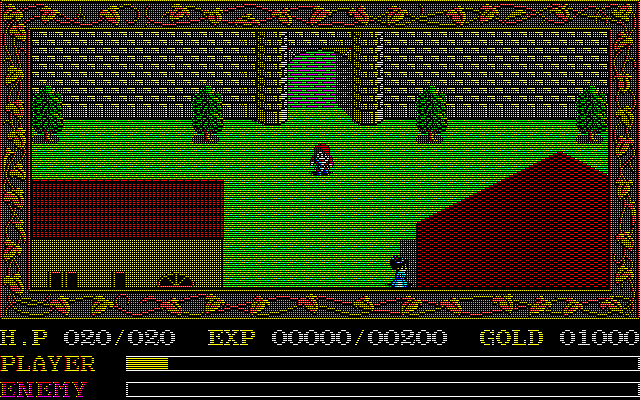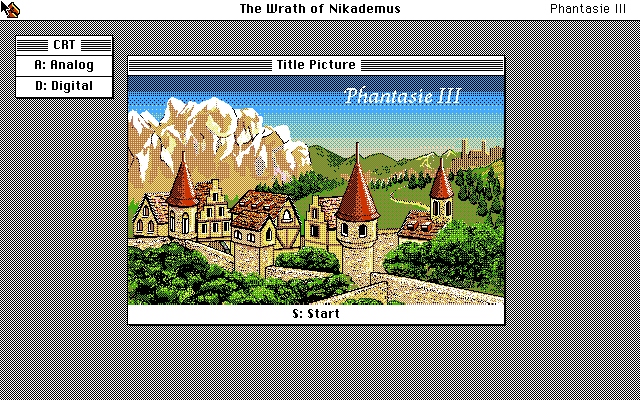|
The NEC PC-9800 series is a line of 16-bit, and later 32-bit personal computers based on the Intel x86 architecture, initially released in 1982 with incremental upgrades up until the year 2000.
In some ways it is analogous to the IBM PC and it's clones, to the point where it received ports of several major operating systems, like MS-DOS, Windows 3.x/9x, NT and 2000, FreeBSD, some Linux-based OSes, and it also had special made ones like PC-PTOS and a port of the PC-8801's N88-BASIC, aptly named N88-BASIC(86).
Do note the term "port"; while in some aspects similar, the PC-9800 architecture deviates from the IBM PC design in several key areas that gave it an edge, leading to it dominating the domestic Japanese market for a whole decade, only folding to the PC behemoth near the turn of the millennium.
The first thing that will catch your eye if it hasn't already is the high out-of-the-box resolution of 640x400, especially by the standards of 1982.
The graphics subsystem of the PC-9800 architecture was designed with the primary goal of clear and detailed output of Japanese text, along with high speed drawing of lines, circles, and polygons.
To achieve this, NEC deployed a full 16-bit Intel 8086 at 5Mhz (unlike the IBM PC's gimped 8088 at 4.77MHz) paired with not one, but two uPD7220 Graphics Display Controller (GDC) chips: one for drawing text, and the other for drawing graphics, each equipped with their own RAM and overlaid over one another for a combined video output.
In contrast, IBM had separated the duties of graphics and high-detail text output to the MDA and CGA cards, the former of which couldn't do bitmapped graphics at all, and the latter's output was highly limited in color and resolution capabilities, topping out at 640x200 black and white, but usually being used at 320x200.
It is for this reason that the IBM PC and it's clones struggled to break into the number 1 position of the Japanese personal computer market share for so long, giving a clear opening for the PC-9801 to take the market for itself.
Over the next two years NEC would offer revised models like the F and M, which had internal floppy drives and an ability to overclock the CPU to 8MHz.
Early games would either be relatively simplistic original titles or ports from the PC-8801 line of computers.
Both would almost always run in 640x200, with the latter almost always using the line-skipped mode for video output instead of the line-doubled mode.
Below is an example of the latter.

The benefits were more than obvious for the business segment, but the increasing spread of PC-9801s at home lead to a growth of the gaming segment as well.
Early PC-9801s were hardly gaming powerhouses, with their memory and processing power generally limiting games to small amounts of action on an 8-color 640x200 output.
However, the release of the PC-9801VM in 1985 which sparked the second generation of the 9800 architecture, brought a ton of upgrades and marked a major change for the gaming and productivity segments.
Gone is the 5/8Mhz 8086, now the standard processor is the NEC V30 at 8/10MHz, bringing with it increased performance per clock, as well as additional instructions from the 80186 chip.
The integrated beeper was no longer limited to an obnoxiously high fixed output frequency and could be redefined through the PIT. This is how the famous "pipo" beep during power-on came to be.
The biggest improvements come in the graphics department, though:
- The Kanji ROM is integrated across the board from this point on
- The new "Graphics Charger" (GRCG) chipset allows parallel read/write access to the bitplanes, similar to VGA latches, enabling almost quadrupled graphics drawing performance compared to earlier models
- The increased RAM for text and graphics (T-VRAM and G-VRAM) provided enough room to make 640x400 bitmap graphics viable + an additional VRAM page, as well as a nearly tripled amount of memory for custom text glyphs, up from the previous 63 to 188
- The 8-color palette was no longer fixed in place. It could now be redefined from a total of 4096 colors, and the number of color entries could be increased to 16 with the PC-9801-24 addon board.
These upgrades (assuming the presence of 16-color hardware) would be the standard specification for the vast majority of PC-98 games going forward, and they are what allowed them to gain that highly detailed and colorful look that most people recognize them with.
Additionally, the YM2203 equipped PC-9801-26 sound board released around this same time put the PC-9800 series on par with the PC-8801 series in terms of sound capabilities.
1986 marked the beginning of the third generation of hardware, started by the PC-9801VX and it's derivatives.
The biggest change is a major upgrade of the CPU: the Intel 80286, bringing with it an extended memory address space up from the previous 1MB to 16MB, introduction of Protected Mode, and nearly doubled IPC
compared to the original 8086. Unfortunately the 286 lacked certain features and instructions that the 186-based V30 had, so it was kept as an optional secondary CPU.
Further expanding the GRCG chipset is the newly introduced Enhanced Graphic Charger (EGC), maintaining backwards compatibility while also introducing a block and line blitter.
The blitter allows fast copies of blocks or lines of pixels from one part of a VRAM page to another, as well as between VRAM pages, further accelerating graphics performance and helping make action games and accelerated GUIs viable on the platform.
Finally, the upgrades of the -24 color board would become standard for all models going forward, ensuring the presence of 16 color graphics capabilities.
Much like in the west, the Protected Mode features of the 286 went largely unused, being mostly treated as a faster 8086 instead.
Below is a comparison shot of a game in 8 and 16 color modes, showing the graphical improvement that a fully maxed out 9801VM or a standard PC-9801VX (and equivalents) can provide.


The release of the fourth generation PC-9801RA in 1988 would begin the start of the 32-bit era of PC-9800s. Not much would change from it's predecessors apart from the addition of a 16MHz 80386,
bringing with it 32-bit Protected Mode and Virtual 8086 Mode, which would help spread the adoption of XMS memory and emulated EMS memory. Certain derivatives would instead be equipped with the slower 386SX.
Adoption of 32-bit hardware would take a while, since the VM had become accepted as the lowest common denominator, and competing clones from Epson would be more on par with the VX. The V30 was still included
for backwards compatibility.
The next several years were a period of laptops catching up, and incremental processor, hard drive, and memory upgrades, ending in 1993 with the 98FELLOW line of machines (PC-9801B), since they began to be superseded by
the PC-9821 series of machines introduced in late 1992.
The defining characteristics of the PC-9821 computers are that they're all 32-bit systems across the board and that they've been given one last upgrade to the standard video system: 256-color 640x480 graphics.
Initially with both planar and packed pixel modes and later with only the packed pixel mode kept, adoption of 256-color modes in games would be rather minimal, limited to western VGA game ports, some adventure games, and Puyo Puyo 2.
Further upgrades would mostly manifest in processors, dedicated GUI accelerator cards for Windows, increased memory, and adoption of standard technologies like IDE, PCI and ATX.
This is all great, but how does it concern me?
All the obvious and subtle differences between each of the models present distinct advantages and disadvantages depending on which era of software interests you the most.
The impact of these differences on your ideal hardware purchase will be described in Buyer's Guide 2.
WORK IN PROGRESS: Need to add some pictures and write the important bits for the 32-bit era.
|


